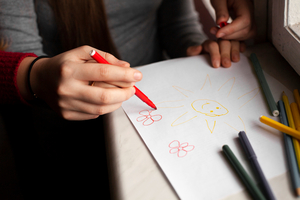Draw your mood
Draw your mood

Draw your mood is a simple icebreaker activity that encourages the group to share their feelings in a safe, creative manner.
Duration: 5m - 15m
Participants: 2 - 20
Difficulty: Low
Goal
Quickly allow participants to share how they're feeling at the start of the session in a creative and non-intrusive way.
Materials
Instructions
Step 1
Start by letting the group know you'll be asking them to share how they feel with a simple drawing and distribute post-it notes and markers to participants.Step 2
Share the framing question verbally or by writing it on your whiteboard or shared canvas. Your framing question might be:- "How are you feeling today?"
- "How are you feeling right now?"
- "What is your mood at the start of this workshop?"
- "If your current mood was an animal, what would it be?"
Step 3
Tell participants they have 3 minutes to draw their response to the question and share how they are feeling visually.- It can be useful to provide some guiding constraints such as "draw your mood in the form of an animal" or "an object you would find in an office."
Step 4
Once the time is up, invite participants to add their post-its to the whiteboard and share a short sentence about their drawing if they would like.Tip & Variations
- In longer workshops and training sessions, I like to leave up the whiteboard and at the end of the session, invite participants to draw a picture for how they feel now. This can be a great point of reflection or to demonstrate how collaborative work can change how we feel.
- You can use this to kick-off project meetings or problem solving sessions by changing the question to something like "How do you feel about [X topic] or [Y initiative]?" In such a setting, you may wish to ask key stakeholders to elaborate on their drawing so that you can ensure you speak to any concerns or blockers.
- When used as a general icebreaker or for general mood, I'd be careful about prying and ensure that folks don't feel pressured to share more about their drawing unless they want to.
- If I notice a lot of frowning or scared faces on drawings, I might ask a follow-up question like "What would help all those scared drawings feel a bit more comfortable in the session?" and invite participants to write a response on another post-it. This can be a great tool to help guide the tone for the session and help participants feel a bit safer.
- This activity can work great online with an online whiteboard, though you may wish to give extra time for drawing in such a setting.
Attachments
- Draw your mood exercise cover.jpg
Author
James Smart is Head of Content at SessionLab. He’s facilitated workshops and designed elearning experiences for places including the University of East Anglia and the National Centre for Writing.
More about author0 Ratings
No ratings yet.